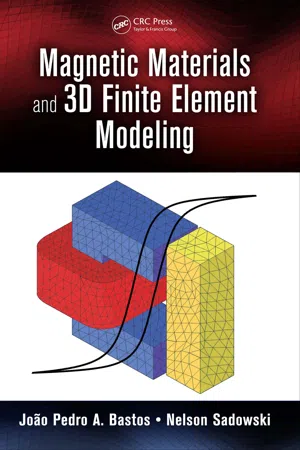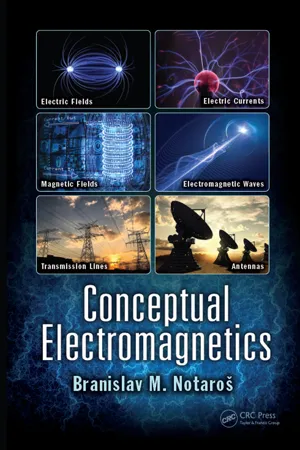Physics
Magnetic Permeability
Magnetic permeability is a measure of a material's ability to support the formation of a magnetic field within itself. It quantifies how easily a material can be magnetized. Materials with high permeability can concentrate magnetic flux, while those with low permeability resist the flow of magnetic flux. The unit of magnetic permeability is Henry per meter (H/m).
Written by Perlego with AI-assistance
Related key terms
Related key terms
1 of 4
Related key terms
1 of 3
6 Key excerpts on "Magnetic Permeability"
- eBook - ePub
- Pradeep Fulay, Jung-Kun Lee(Authors)
- 2016(Publication Date)
- CRC Press(Publisher)
Figure 11.12b .In antiferromagnetic materials, there is no net magnetic moment because the magnetic moments cancel out. However, as we increase the temperature, the extent of antiparallel coupling is reduced. This causes the magnetic susceptibility to increase (i.e., 1/χm decreases) with increase in temperature. This increase in the susceptibility continues until temperature increases to Néel temperature (T N or θN ), at which an antiferromagnetic material becomes paramagnetic (Figure 11.12c ).11.5.2 MAGNETIC PERMEABILITY (μ)In addition to saturation magnetization, many other properties of ferromagnetic and ferrimagnetic materials, important for different applications, are often specified. These include the initial (low-field) and high-field permeabilities.As can be seen from Figures 11.6 and 11.16 , the Magnetic Permeability (μ) of ferromagnetic and ferrimagnetic materials depends strongly on the strength of the applied magnetic field (H ).At very low fields, the Magnetic Permeability is low because the applied field is not sufficient to cause any kind of domain growth. This is often referred to as the initial permeability (μi ). As the field increases, the domains are aligned along the direction of the magnetic field. This is similar to the orientation of domains in ferroelectric materials. As the domains become oriented, a relatively sharp increase in magnetization occurs. This is why, in this region, the Magnetic Permeability increases significantly to μmax (Figure 11.16 ). As the field approaches relatively high values, in which essentially all domains are aligned, the permeability begins to decrease again (Figures 11.6 and 11.16 ). This is the saturation region. What this means is that the material cannot accept any more flux, that is, it essentially becomes impermeable to the magnetic field. In the designing of magnetic circuits, often, care has to be taken not to create such bottlenecks that effectively will not allow any more magnetic flux to pass through. As shown in Figure 11.17 , if the applied field is not enough to cause saturation, we get what is called a minor loop. - João Pedro A. Bastos, Nelson Sadowski(Authors)
- 2017(Publication Date)
- CRC Press(Publisher)
H is applied, the magnetic fields of the domains tend to align with the external field. When the external field is removed, in the second case, the domains maintain their alignment. The cumulative effect of the magnetic domains forms the remnant flux density of the permanent magnet.In soft magnetic materials, the situation is approximately the same; however, the application of a weak external magnetic field in the direction opposite to the internal field is sufficient to eliminate the remnant flux density, as opposed to the situation in permanent magnets.1.8.1 DIAMAGNETIC MATERIALSDiamagnetic materials have a relative permeability slightly lower than 1. Notable materials in this group are mercury, gold, silver, and copper. Copper, for example, has a relative permeability μr= 0.999991; the other materials possess μrof the same order of magnitude. In practice we can consider these materials as having μrequal to 1. One effect of diamagnetism is illustrated in Figure 1.23 . A diamagnetic material is placed under the influence of a uniform field. Since μr< 1, more of the flux passes through air than through the material, since air is a more permeable material. This causes a force that tends to repel the diamagnetic body from the source generating the field. However, because the permeability is very close to 1, this effect is very small and difficult to measure.FIGURE 1.23 A diamagnetic material in a magnetic field. Flux lines tend to pass through free space because it has lower reluctance than the diamagnetic material. The diamagnetic material is repelled by the field.1.8.2 PARAMAGNETIC MATERIALSParamagnetic materials possess a relative permeability μrslightly larger than 1. One example of this type of materials is aluminum, for which μr- eBook - ePub
Functional Molecular Materials
An Introductory Textbook
- Matteo Atzori, Flavia Artizzu(Authors)
- 2018(Publication Date)
- Jenny Stanford Publishing(Publisher)
B is simply the vector sum of the two contributions:(2.11)B =μ 0( H + M )whereis given in T andBandMin A m -1 . If both magnetization and magnetic field are present, their contributions can be added up to give the global value of magnetic induction.H2.1.4.2 Magnetic Permeability and susceptibilityIt is now possible to define the Magnetic Permeability μ as:(2.12)μ =B Hand the magnetic susceptibility χ as:(2.13)χ =M HSinceThis quantity is particularly useful as it provides an evaluation of the magnetization of a certain material that is independent of the applied magnetic field used to perform the measurement.andBmay or may not be linear functions ofMdepending on the type of material or medium, it should be noted that the permeability and susceptibility may or may not be constant.H ,Although the magnetic susceptibility χ is a dimensionless unit, it is actually common in experimental practice to refer to magnetic susceptibility per mass unit χm(cm3 g -1 ) or to molar magnetic susceptibility χmo 1(cm3 mo 1−1 ).The values assumed by the magnetic susceptibility can be used to classify the conventional classes of magnetic materials. Materials having a small and negative χ , typicallyare called diamagnets, and their magnetic response opposes the magnetic field. Superconductors are a special group of diamagnets for which χ ≈ - 1. Materials having a small and positive χ , typicallyχ ≈ -10t- 5are paramagnets. The magnetization of paramagnets is weak but aligned parallel with the direction of the applied magnetic field. A third type of magnetic materials is of that ferromagnets, for which the susceptibility is positive and much greater than 1; . typical χ values are found in the 101 - 105χ ≈10-- 310,- 5 - eBook - ePub
- Ortwin Hess, Tatjana Gric(Authors)
- 2018(Publication Date)
- Elsevier(Publisher)
A phenomenon in materials where electric fields can be created by mechanical compression in some directions is called piezoelectricity. The former can be explained by a relative displacement of positive and negative charges resulting in an induced dipole. On thermodynamic grounds, it is expected that for such materials also the opposite effect takes place, which is indeed the case: the application of a potential difference in the material creates a mechanical distortion. This effect is often characterized as the direct piezoelectric effect. The mechanical relation linking the stress and strain is cross-coupled to the electrical effect and this appears in the (electrical) constitutive equations. The constitutive relations in case of piezoelectric materials are more complicated than for ordinary anisotropic materials due to the mechanical stresses and strains themselves being the second-order tensors, and hence their relations with electric field and flux density have to be described by the cross-coupling third-order tensors.Magnetic materials
For magnetic materials the permeability is the dominating parameter expressing the relation between B and HB =μ 0H + M= μ H(40)where M is the magnetic moment density (magnetization) and μ is the permeability. (Almost in all magnetic materials the medium is also electrically polarizable, and the name magneto-dielectric is used.)Magneto-dielectric materials
Materials described by permittivity and permeability are called magneto-dielectric.Magneto-dielectric materials with negative permittivity and permeability
The sign of the real parts of permittivity and permeability is not limited by any physical law and can be negative. The real part of the permittivity is negative, for example, in metals, the former phenomenon takes place due to the presence of the free electrons moving in the applied electric field and creating a polarization which is out of phase with the applied field. The plasma frequency denotes the resonant frequency of free-electron oscillations and depends on the electron density and effective electron mass. For metals, this frequency is in the ultraviolet range, leading to very large negative values of the real part of the permittivity at the microwave frequencies (range of GHz) and below. However, at these frequencies the imaginary part of the permittivity dominates due to very high conductivity of metals. - eBook - ePub
- Anupam Garg(Author)
- 2012(Publication Date)
- Princeton University Press(Publisher)
16 Magnetostatics in matterOur purpose in this chapter is to obtain a theory for the spatially averaged or macroscopic magnetic field in matter and to develop models for the response of certain types of materials to applied magnetic fields. While the mathematical development parallels that of electrostatics in dielectrics, the physics is quite different. The biggest difference is that, unlike the electric case, the magnetic susceptibility may be either positive or negative, i.e., the magnetic response can either oppose or reinforce the applied field. The two cases are known as diamagnetic and paramagnetic , respectively. This difference can be traced to the lack of any work done by the magnetic field on a moving charge. Second, except for ferromagnets and superconductors, the response is much weaker than in the electric case. Thus, there is often little penalty for confusing the magnetic field B with the magnetizing field H , and many authors even use the symbols interchangeably. This leads to much confusion, which we shall avoid with only partial success.100 Magnetic Permeability and susceptibility
In magnetostatics, where we study only steady-state situations, the macroscopic equations to be solved are Ampere’s law,and the law that B is solenoidal,As in the electrostatic case, one needs a constitutive relation between B and H to solve eqs. (100.1) and (100.2). For many materials a linear relationship holds to very good approximation over a large range. If the material is isotropic, we write1The dimensionless number μ (in the Gaussian system), or μ/μ 0 (in SI), is known as the permeability of the medium. It has the same value in the two systems. In solid or liquid crystals, it must be replaced by a tensor.We also define the magnetic susceptibility in parallel with the electric susceptibility:This is related to the permeability via It is also a dimensionless number, butFor the majority of materials for which eq. (100.3) is a good approximation,χmis very small, of order 10−5 . As mentioned above, unlikeχe,χmcan be either positive (paramagnets ) or negative (diamagnets ). Because of the smallness ofχm, if either a para- or diamagnetic body is placed in an external B - eBook - ePub
- Branislav M. Notaroš(Author)
- 2017(Publication Date)
- CRC Press(Publisher)
MAGNETOSTATIC FIELD IN MATERIAL MEDIA IntroductionIn analysis of the magnetostatic field in the presence of magnetic materials, many basic concepts, physical laws, and mathematical techniques are entirely analogous to the corresponding concepts, laws, and techniques in electrostatics (Chapter 2 ). Magnetized materials can be represented by vast collections of tiny atomic current loops, i.e., magnetic dipoles, while the concept of permeability of a medium allows for macroscopic characterization of materials and their fields. The most important difference, however, with respect to the analysis of dielectric materials is the inherent nonlinear behavior of the most important class of magnetic materials, called ferromagnetics. This is a class of materials with striking magnetic properties (many orders of magnitude stronger than in other materials), with iron as a typical example. Analysis of magnetic circuits (consisting of ferromagnetic cores of different shapes with current-carrying windings), which is a culmination of our study of the magnetostatic field in material media, thus essentially resembles the dc analysis of nonlinear electric circuits. In addition, configurations of current-carrying conductors store magnetic energy. For systems that contain ferromagnetic materials with pronounced nonlinearity, the energy balance in the system includes so-called hysteresis losses in the material.5.1 Magnetization CurrentAccording to the elementary atomic model of matter, all materials are composed of atoms, each with a central fixed positively charged nucleus and a number of negatively charged electrons circulating around the nucleus in various orbits. Both these orbital motions and the inherent spins of the electrons about their own axes can be represented by small current loops, also referred to as magnetic dipoles. The magnetic moment of each loop is given by m = IS, where I is the current intensity of the loop and S is the loop surface area vector, oriented in accordance to the right-hand rule with respect to the reference direction of the current. With an applied magnetic field, these current loops experience torques, which lead to a net alignment of microscopic magnetic dipole moments with the external field and a net magnetic moment in the material, and this process is known as the magnetization of the material. However, instead of analyzing every single atom and all microscopic magnetic dipole moments, we introduce a macroscopic quantity termed the magnetization vector and defined as [note the analogy with Eq. (2.2)
Index pages curate the most relevant extracts from our library of academic textbooks. They’ve been created using an in-house natural language model (NLM), each adding context and meaning to key research topics.
Explore more topic indexes
Explore more topic indexes
1 of 6
Explore more topic indexes
1 of 4





